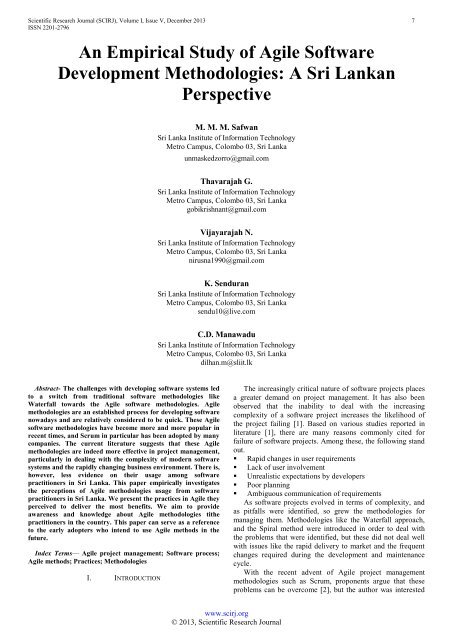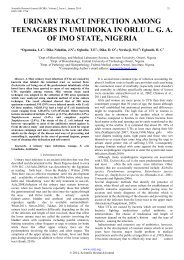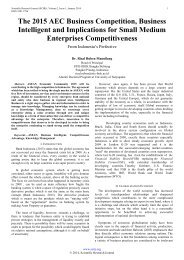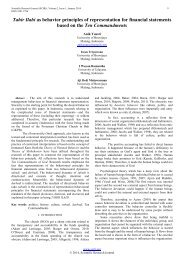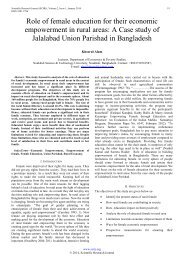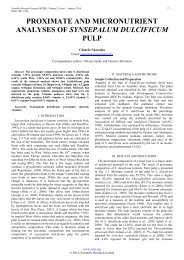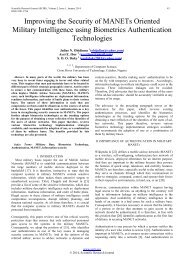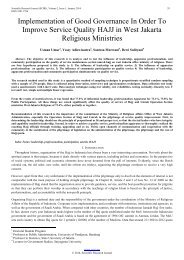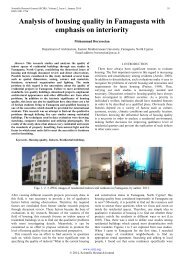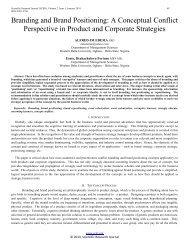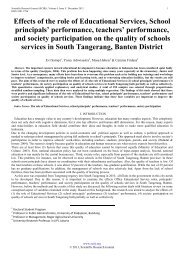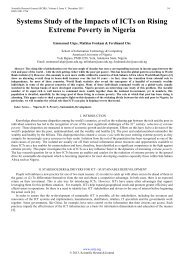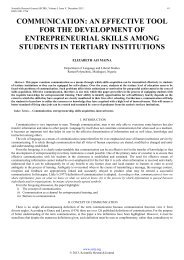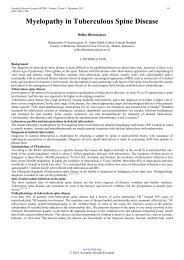An Empirical Study of Agile Software Development Methodologies: A Sri Lankan Perspective
The challenges with developing software systems led to a switch from traditional software methodologies like Waterfall towards the Agile software methodologies. Agile methodologies are an established process for developing software nowadays and are relatively considered to be quick. These Agile software methodologies have become more and more popular in recent times, and Scrum in particular has been adopted by many companies. The current literature suggests that these Agile methodologies are indeed more effective in project management, particularly in dealing with the complexity of modern software systems and the rapidly changing business environment. There is, however, less evidence on their usage among software practitioners in Sri Lanka. This paper empirically investigates the perceptions of Agile methodologies usage from software practitioners in Sri Lanka. We present the practices in Agile they perceived to deliver the most benefits. We aim to provide awareness and knowledge about Agile methodologies tithe practitioners in the country. This paper can serve as a reference to the early adopters who intend to use Agile methods in the future. http://www.scirj.org/december-2013-paper.php?rp=P121344
The challenges with developing software systems led to a switch from traditional software methodologies like Waterfall towards the Agile software methodologies. Agile methodologies are an established process for developing software nowadays and are relatively considered to be quick. These Agile software methodologies have become more and more popular in recent times, and Scrum in particular has been adopted by many companies. The current literature suggests that these Agile methodologies are indeed more effective in project management, particularly in dealing with the complexity of modern software systems and the rapidly changing business environment. There is, however, less evidence on their usage among software practitioners in Sri Lanka. This paper empirically investigates the perceptions of Agile methodologies usage from software practitioners in Sri Lanka. We present the practices in Agile they perceived to deliver the most benefits. We aim to provide awareness and knowledge about Agile methodologies tithe practitioners in the country. This paper can serve as a reference to the early adopters who intend to use Agile methods in the future.
http://www.scirj.org/december-2013-paper.php?rp=P121344
Create successful ePaper yourself
Turn your PDF publications into a flip-book with our unique Google optimized e-Paper software.
Scientific Research Journal (SCIRJ), Volume I, Issue V, December 2013 7<br />
ISSN 2201-2796<br />
<strong>An</strong> <strong>Empirical</strong> <strong>Study</strong> <strong>of</strong> <strong>Agile</strong> S<strong>of</strong>tware<br />
<strong>Development</strong> <strong>Methodologies</strong>: A <strong>Sri</strong> <strong>Lankan</strong><br />
<strong>Perspective</strong><br />
M. M. M. Safwan<br />
<strong>Sri</strong> Lanka Institute <strong>of</strong> Information Technology<br />
Metro Campus, Colombo 03, <strong>Sri</strong> Lanka<br />
unmaskedzorro@gmail.com<br />
Thavarajah G.<br />
<strong>Sri</strong> Lanka Institute <strong>of</strong> Information Technology<br />
Metro Campus, Colombo 03, <strong>Sri</strong> Lanka<br />
gobikrishnant@gmail.com<br />
Vijayarajah N.<br />
<strong>Sri</strong> Lanka Institute <strong>of</strong> Information Technology<br />
Metro Campus, Colombo 03, <strong>Sri</strong> Lanka<br />
nirusna1990@gmail.com<br />
K. Senduran<br />
<strong>Sri</strong> Lanka Institute <strong>of</strong> Information Technology<br />
Metro Campus, Colombo 03, <strong>Sri</strong> Lanka<br />
sendu10@live.com<br />
C.D. Manawadu<br />
<strong>Sri</strong> Lanka Institute <strong>of</strong> Information Technology<br />
Metro Campus, Colombo 03, <strong>Sri</strong> Lanka<br />
dilhan.m@sliit.lk<br />
Abstract- The challenges with developing s<strong>of</strong>tware systems led<br />
to a switch from traditional s<strong>of</strong>tware methodologies like<br />
Waterfall towards the <strong>Agile</strong> s<strong>of</strong>tware methodologies. <strong>Agile</strong><br />
methodologies are an established process for developing s<strong>of</strong>tware<br />
nowadays and are relatively considered to be quick. These <strong>Agile</strong><br />
s<strong>of</strong>tware methodologies have become more and more popular in<br />
recent times, and Scrum in particular has been adopted by many<br />
companies. The current literature suggests that these <strong>Agile</strong><br />
methodologies are indeed more effective in project management,<br />
particularly in dealing with the complexity <strong>of</strong> modern s<strong>of</strong>tware<br />
systems and the rapidly changing business environment. There is,<br />
however, less evidence on their usage among s<strong>of</strong>tware<br />
practitioners in <strong>Sri</strong> Lanka. This paper empirically investigates<br />
the perceptions <strong>of</strong> <strong>Agile</strong> methodologies usage from s<strong>of</strong>tware<br />
practitioners in <strong>Sri</strong> Lanka. We present the practices in <strong>Agile</strong> they<br />
perceived to deliver the most benefits. We aim to provide<br />
awareness and knowledge about <strong>Agile</strong> methodologies tithe<br />
practitioners in the country. This paper can serve as a reference<br />
to the early adopters who intend to use <strong>Agile</strong> methods in the<br />
future.<br />
Index Terms— <strong>Agile</strong> project management; S<strong>of</strong>tware process;<br />
<strong>Agile</strong> methods; Practices; <strong>Methodologies</strong><br />
I. INTRODUCTION<br />
The increasingly critical nature <strong>of</strong> s<strong>of</strong>tware projects places<br />
a greater demand on project management. It has also been<br />
observed that the inability to deal with the increasing<br />
complexity <strong>of</strong> a s<strong>of</strong>tware project increases the likelihood <strong>of</strong><br />
the project failing [1]. Based on various studies reported in<br />
literature [1], there are many reasons commonly cited for<br />
failure <strong>of</strong> s<strong>of</strong>tware projects. Among these, the following stand<br />
out.<br />
• Rapid changes in user requirements<br />
• Lack <strong>of</strong> user involvement<br />
• Unrealistic expectations by developers<br />
• Poor planning<br />
• Ambiguous communication <strong>of</strong> requirements<br />
As s<strong>of</strong>tware projects evolved in terms <strong>of</strong> complexity, and<br />
as pitfalls were identified, so grew the methodologies for<br />
managing them. <strong>Methodologies</strong> like the Waterfall approach,<br />
and the Spiral method were introduced in order to deal with<br />
the problems that were identified, but these did not deal well<br />
with issues like the rapid delivery to market and the frequent<br />
changes required during the development and maintenance<br />
cycle.<br />
With the recent advent <strong>of</strong> <strong>Agile</strong> project management<br />
methodologies such as Scrum, proponents argue that these<br />
problems can be overcome [2], but the author was interested<br />
www.scirj.org<br />
© 2013, Scientific Research Journal
Scientific Research Journal (SCIRJ), Volume I, Issue V, December 2013 8<br />
ISSN 2201-2796<br />
in studying whether, particularly in the <strong>Sri</strong> <strong>Lankan</strong> context, a<br />
quantifiable improvement has been made with the transition<br />
into <strong>Agile</strong> methodologies. <strong>Agile</strong> methods provide ways to<br />
develop s<strong>of</strong>tware which place emphasis on people and their<br />
creativity [3]. Despite the benefits that <strong>Agile</strong> can deliver, little<br />
work has been published regarding its current usage in <strong>Sri</strong><br />
Lanka [4]. If the methods are to be used, we need to<br />
understand how <strong>Agile</strong> methods are being practiced within this<br />
region. How is the practice perceived by the practitioners in<br />
<strong>Sri</strong> Lanka? What challenges and benefits have they<br />
experienced when using the methodologies? How they<br />
overcome those challenges? <strong>Agile</strong> methods are not for<br />
everyone. In one <strong>of</strong> the sessions for an invited talk at the<br />
XP2011 Conference, titled ‘When <strong>Agile</strong> is not enough’; the<br />
speaker stated: “what works in one culture, will not<br />
necessarily work in other cultures”. We agree with this<br />
statement and intend to investigate the scenario in the country.<br />
Several studies stated that addressing cultural differences is<br />
important for the success <strong>of</strong> s<strong>of</strong>tware development [5, 6]. One<br />
study [5] although the paper discussed global s<strong>of</strong>tware<br />
development, we believe that some cultural aspects discussed<br />
in the paper can be related to the usage <strong>of</strong> <strong>Agile</strong> methods.<br />
A. Research Questions<br />
In this paper, several questions will be addressed:<br />
• What do practitioners say about awareness <strong>of</strong> <strong>Agile</strong> in<br />
the country?<br />
• What are the first reason(s) making they started to use<br />
<strong>Agile</strong> methods?<br />
• What are the challenges they faced when using <strong>Agile</strong>?<br />
• Despite the challenges, what are <strong>Agile</strong> Practices<br />
perceived to deliver the greatest benefits to them?<br />
B. Objectives and Expected Contribution<br />
We will describe the perceptions <strong>of</strong> practitioners in the<br />
country in terms <strong>of</strong> awareness, <strong>Agile</strong> introduction, challenges<br />
they are facing, and the benefits they obtained when using the<br />
methods. The challenges <strong>of</strong> using <strong>Agile</strong> methods can serve as<br />
guidelines for s<strong>of</strong>tware practitioners in <strong>Sri</strong> Lanka and the<br />
nearby region where only limited studies about this field exist.<br />
It is hoped that the findings will help to reduce the difficulties<br />
encountered when they are trying to introduce <strong>Agile</strong><br />
methodologies. In addition, this study will help add to the<br />
empirical evidence <strong>of</strong> s<strong>of</strong>tware engineering knowledge and<br />
s<strong>of</strong>tware processes in terms <strong>of</strong> <strong>Agile</strong> methods usage. We hope<br />
that based on our findings from this study, the usage <strong>of</strong> the<br />
methods will increase and at the same time, add to the<br />
awareness <strong>of</strong> the <strong>Agile</strong> methodologies in the country.<br />
<strong>Agile</strong> methods are established methodology that is<br />
believed to produce faster results when developing s<strong>of</strong>tware.<br />
Nonetheless, <strong>Agile</strong> is not a silver bullet replacing traditional<br />
methods <strong>of</strong> s<strong>of</strong>tware engineering, such as the Waterfall model.<br />
However, to get the best out <strong>of</strong> <strong>Agile</strong>, it must be adapted to the<br />
people and organization <strong>of</strong> the adopters. While <strong>Agile</strong> became<br />
mainstream in the development <strong>of</strong> s<strong>of</strong>tware in the Western<br />
countries (such as Europe, Australia and Northern America), it<br />
is not the case in other regions: Southeast Asia region [4] and<br />
countries such as <strong>Sri</strong> Lanka. For them, <strong>Agile</strong> is new and some<br />
have never heard <strong>of</strong> the method [7].<br />
Furthermore, with the importance <strong>of</strong> s<strong>of</strong>tware industries to<br />
the country, it is necessary to provide baseline on how to use<br />
s<strong>of</strong>tware processes that can be adapted to frequent change in<br />
the business environment.<br />
This paper will present the perception from practitioners in<br />
<strong>Sri</strong> Lanka on the emergence <strong>of</strong> <strong>Agile</strong> methodologies. In this<br />
paper, their awareness will be considered. Challenges<br />
associated with the introduction <strong>of</strong> <strong>Agile</strong> methods will be<br />
presented, together with solutions suggested by the<br />
practitioners. The practices perceived to deliver the most<br />
benefits are also presented. As qualitative study is always<br />
concerned with validity and reliability <strong>of</strong> the findings, these<br />
issues are discussed before we conclude the paper.<br />
This research paper is structured into two sections. Section<br />
2 will contain the literature review on this topic and the details<br />
<strong>of</strong> the background study that has been conducted. The final<br />
section will consist <strong>of</strong> all the references that have been cited in<br />
this paper.<br />
II.<br />
LITERATURE REVIEW<br />
Although there are some papers about the perception from<br />
adopters <strong>of</strong> <strong>Agile</strong> methods, however, these studies were<br />
mainly carried out in Western countries such as Canada, the<br />
European region and the United States [8-10]. This chapter<br />
describes how <strong>Agile</strong> s<strong>of</strong>tware methodologies have emerged<br />
over the years in <strong>Sri</strong> Lanka.<br />
A. <strong>Agile</strong> S<strong>of</strong>tware <strong>Development</strong><br />
The use <strong>of</strong> iterative and incremental s<strong>of</strong>tware development<br />
techniques accelerated during the latter half <strong>of</strong> the 1990s [11].<br />
At the same time, new s<strong>of</strong>tware development methodologies<br />
began to exploit these techniques, espouse flexible rules <strong>of</strong><br />
project behavior, and focus on human interactions. By early<br />
2001, the word <strong>Agile</strong> was selected to describe s<strong>of</strong>tware<br />
development methodologies adhering to these joint principles<br />
[12]. The emergence <strong>of</strong> <strong>Agile</strong> methodologies, however, can be<br />
said to have begun in the mid- 1990s, when s<strong>of</strong>tware<br />
methodologies and techniques such as Extreme Programming<br />
(XP), Scrum, eXtreme Testing, Crystal Family <strong>of</strong><br />
<strong>Methodologies</strong>, Dynamic Systems <strong>Development</strong> Method<br />
(DSDM), Adaptive S<strong>of</strong>tware <strong>Development</strong> (ASD), and<br />
Feature-Driven <strong>Development</strong> (FDD) began to emerge. Since<br />
then, <strong>Agile</strong> s<strong>of</strong>tware development methods have gained<br />
popularity and have become increasingly important to a<br />
significant number <strong>of</strong> s<strong>of</strong>tware development organizations<br />
[13, 14]. In a short time, agile development has attracted huge<br />
interest from the s<strong>of</strong>tware industry. A survey in the USA and<br />
Europe reveals that 14% <strong>of</strong> companies are using agile<br />
methods, and that 49% <strong>of</strong> the companies that are aware <strong>of</strong><br />
agile methods are interested in adopting them [15].The area <strong>of</strong><br />
<strong>Agile</strong> s<strong>of</strong>tware development methodologies has been<br />
researched twosome extent [16] and has gained a lot <strong>of</strong><br />
attention mainly because <strong>of</strong> its potential to improve customer<br />
satisfaction, decrease defects rates, and shorten development<br />
time along with its capability to accommodate rapidly<br />
changing requirements [17, 18, 19].<br />
B. A Model for Measuring the Effectiveness <strong>of</strong> <strong>Agile</strong><br />
<strong>Methodologies</strong><br />
Chow and Cao [20] proposed a model for identifying the<br />
Critical Success Factors for projects that use <strong>Agile</strong><br />
methodologies (See Figure 1). They identified the following<br />
as key factors which may affect the success or failure <strong>of</strong> an<br />
<strong>Agile</strong> s<strong>of</strong>tware project.<br />
• Organizational factors, such as management commitment<br />
and organizational environment,<br />
www.scirj.org<br />
© 2013, Scientific Research Journal
Scientific Research Journal (SCIRJ), Volume I, Issue V, December 2013 9<br />
ISSN 2201-2796<br />
• People factors, such as team capability and customer<br />
involvement<br />
• Process factors, such as the project management process<br />
and project definition process<br />
• Technical factors such as <strong>Agile</strong> s<strong>of</strong>tware development<br />
techniques and the delivery strategy<br />
• Project factors such as project nature and project type<br />
Fig. 1. Chow and Cao’s Research Model<br />
C. The Importance <strong>of</strong> S<strong>of</strong>tware Industries and S<strong>of</strong>tware<br />
Process in <strong>Sri</strong> Lanka<br />
S<strong>of</strong>tware industry is acknowledged worldwide to be the<br />
fastest growing sector. Throughout the last decade there was a<br />
trend for the s<strong>of</strong>tware industry to move from advanced high<br />
wage countries, towards low waged countries in Asia.<br />
According to analysts this trend will continue during the<br />
coming decade. During the last decade India made the best use<br />
<strong>of</strong> the above scenario and was able increase s<strong>of</strong>tware exports<br />
considerably, to achieve annual growth rate <strong>of</strong> over 50%.<br />
Though <strong>Sri</strong> Lanka is lagging far behind, it has the potential to<br />
improve the enabling factors and make s<strong>of</strong>tware industry the<br />
main foreign exchange earner <strong>of</strong> the country within a<br />
relatively short period [21].Realizing the important<br />
contribution <strong>of</strong> the s<strong>of</strong>tware industry to the economic growth<br />
and how it can help the community, <strong>Sri</strong> Lanka has started<br />
focusing on it. This is important in order to transform the<br />
country into a developed and technological country.<br />
In order to have smooth operation <strong>of</strong> s<strong>of</strong>tware development<br />
and successful deployment <strong>of</strong> the industry in ICT, the needs <strong>of</strong><br />
s<strong>of</strong>tware processes are considered to be critical. The problems<br />
found from one study [22] show that <strong>Sri</strong> Lanka is still lacking<br />
the usage <strong>of</strong> s<strong>of</strong>tware processes. Besides, the problems in<br />
terms <strong>of</strong> delivering quality products have also been identified<br />
[21]. In addition, recent investigation has discovered that<br />
companies in <strong>Sri</strong> Lanka do not have a clear methodology that<br />
illustrates how the requirements can be obtained [21].<br />
The need for a good s<strong>of</strong>tware process is important as it can<br />
help practitioners define their requirements. These problems<br />
have motivated us to introduce <strong>Agile</strong> methods in the country.<br />
As <strong>Agile</strong> emphasis on collaboration with customers and having<br />
works iteratively and incrementally, it will help to reduce some<br />
<strong>of</strong> the associated problems [21]. We expect the problems can<br />
be minimized with the application <strong>of</strong> the methods. To the best<br />
<strong>of</strong> our knowledge and based on a review <strong>of</strong> literature, we found<br />
very little information and published studies about <strong>Agile</strong><br />
methods used in <strong>Sri</strong> Lanka.<br />
III.<br />
METHODOLOGY<br />
This section provides the road map to achieve the research<br />
objectives. The section presents the research design by<br />
describing the research approach, target population, sample<br />
size, sampling technique, data collection and data analysis<br />
methods.<br />
We employed two methods, initially conducting semistructured<br />
interviews from each company and later collecting<br />
the team’s perception via an online survey. This facilitated the<br />
involvement <strong>of</strong> many team members, allowing the comparison<br />
<strong>of</strong> their opinions. At the same time, through these <strong>of</strong> openended<br />
questions, it permitted maintaining a qualitative view<br />
on the project environment, without having to conduct<br />
interviews with every single team member.<br />
In this study, we conducted a qualitative semi structured<br />
interview to understand the perception <strong>of</strong> new adopters in <strong>Sri</strong><br />
Lanka. As s<strong>of</strong>tware development deals with human factors, a<br />
qualitative study therefore helps in understanding the<br />
respondents’ behavior, and to identify the unknown and never<br />
explored scenarios [22]. Unlike the quantitative approach, a<br />
qualitative study will help to describe what is actually<br />
happening when <strong>Agile</strong> methods was implemented [23].<br />
Moreover, the systematic review also included qualitative<br />
and quantitative research studies, published up to and<br />
including2013. Only studies written in English were included.<br />
The search strategy included electronic databases and hand<br />
searches <strong>of</strong> conference proceedings. The following electronic<br />
databases were searched:<br />
• ACM Digital Library<br />
• IEEE Xplore<br />
• ISI Web <strong>of</strong> Science<br />
In addition, we searched many volumes <strong>of</strong> the following<br />
conference proceedings for research papers:<br />
• <strong>Agile</strong> Universe<br />
• <strong>Agile</strong> <strong>Development</strong> Conference<br />
A. <strong>Study</strong> Design<br />
Questions in this interview were developed from the<br />
findings obtained in the baseline study [7]. The issues<br />
identified in the baseline study have been the basic references<br />
and consequently created hypotheses investigating the<br />
perception <strong>of</strong> s<strong>of</strong>tware practitioners when using <strong>Agile</strong><br />
methods. This is a semi-structure interview and therefore the<br />
questions are adapted to the answers given by the participants.<br />
The interviews mainly focus on capturing the project specific<br />
demographics. These demographics include time and the cost<br />
factors. The semi structured interviews facilitated the research<br />
to gather answers not only for set <strong>of</strong> pre-defined questions, but<br />
also for some important hidden information. Then we<br />
designed a preliminary questionnaire to obtain relevant<br />
information for the research.<br />
B. Participants<br />
Since this is a qualitative study, therefore the participants<br />
are purposely chosen rather than at random. The suggestion<br />
www.scirj.org<br />
© 2013, Scientific Research Journal
Scientific Research Journal (SCIRJ), Volume I, Issue V, December 2013 10<br />
ISSN 2201-2796<br />
behind the qualitative study is to purposefully select<br />
participants. The participants chosen are based on the<br />
following criteria; s<strong>of</strong>tware practitioners including developers,<br />
testers, system analyst, business analyst and project managers<br />
involved in <strong>Agile</strong> project. Taking benefits from their positions<br />
is consistent with the objective <strong>of</strong> the study. The benefit <strong>of</strong> this<br />
purposive sampling is to allow the researcher understanding<br />
the scenario from the right participants. We conducted<br />
interviews with a s<strong>of</strong>tware architect to collect in depth and in<br />
detailed information.<br />
C. Data Collection<br />
We identified the major s<strong>of</strong>tware development companies<br />
in the island and considered the IT companies providing<br />
s<strong>of</strong>tware development services. We sent e-mails to these<br />
companies inquiring their ability to provide information for<br />
the above research. Out <strong>of</strong> them only two companies agreed to<br />
provide data – Zone24x7 and <strong>Sri</strong> <strong>Lankan</strong> Airlines IT<br />
Department. The data were collected from two s<strong>of</strong>tware<br />
organizations in <strong>Sri</strong> Lanka, between August and September<br />
2013, involving61 s<strong>of</strong>tware practitioners. The purpose and<br />
implications <strong>of</strong> the research were explained to the participant<br />
before we started the interview. At the same time, we sought<br />
prior consent from the participant by providing form to be<br />
signed. Our study has been granted an ethical approval under<br />
<strong>Sri</strong> Lanka Institute <strong>of</strong> Information Technology. The interviews<br />
were recorded using a voice recorder. Hand written notes were<br />
also taken while the interviews were recorded. This is<br />
important for reference and can be compared with our<br />
recorded data later on in the analysis stages. As already<br />
mentioned above, the research collected data not only through<br />
interviews, but also by providing questionnaires to QA leads,<br />
Developers and Testers. The questionnaires were distributed<br />
mainly via e-mails and helped the research to obtain<br />
information from a large number <strong>of</strong> personnel.<br />
D. Data <strong>An</strong>alysis<br />
The data were transcribed and they were compared with<br />
the notes we took during the interview. We ensured only the<br />
relevant data were transcribed. The results were entered into<br />
spread sheet and the calculations were done. Data were<br />
presented using pie charts and bar charts with the help <strong>of</strong><br />
Micros<strong>of</strong>t Excel. Results were categorized as follows:<br />
• The percentage <strong>of</strong> respondents classified according to<br />
their roles.<br />
• The percentage <strong>of</strong> respondents who adopt <strong>Agile</strong><br />
methodologies in s<strong>of</strong>tware development process.<br />
• The percentages <strong>of</strong> different <strong>Agile</strong> methods used by the<br />
respondents.<br />
• The percentage <strong>of</strong> reasons for using <strong>Agile</strong> methods.<br />
• The percentage <strong>of</strong> different problems faced.<br />
• The percentage <strong>of</strong> different benefits obtained.<br />
• The percentage <strong>of</strong> respondents who thinks <strong>Agile</strong><br />
<strong>Methodologies</strong> are important and vice versa.<br />
• The percentage <strong>of</strong> reasons for considering <strong>Agile</strong><br />
<strong>Methodologies</strong> as important and vice versa.<br />
• The percentage <strong>of</strong> areas where <strong>Agile</strong> methods are expected<br />
to play an important role.<br />
IV.<br />
RESULTS AND DISCUSSION<br />
was gathered using interviews and questionnaires. A total <strong>of</strong><br />
61 responses were received including the interview.<br />
The information we got from questionnaire responses were<br />
studied, analyzed and represented in graphical format as<br />
follows:<br />
A. Sample Categorized by Roles<br />
As shown in Fig. 2. out <strong>of</strong> 60 respondents 45% are quality<br />
assurance managers,25% are s<strong>of</strong>tware developers, 8% are<br />
project managers and system architects. It can be depicted that<br />
92% <strong>of</strong> the respondents are surely involved in s<strong>of</strong>tware<br />
development processes. The balance 8% maybe or may not be<br />
involved in s<strong>of</strong>tware development processes but definitely<br />
related to IT and s<strong>of</strong>tware.<br />
Fig. 2.Proportion <strong>of</strong> respondents in terms <strong>of</strong> their roles<br />
B. <strong>Agile</strong> <strong>Methodologies</strong> Practitioner Statistics<br />
Fig. 3. Proportion <strong>of</strong> respondents based on usage <strong>of</strong> agile methodologies<br />
As displayed in Fig. 3. 68% <strong>of</strong> the respondents are<br />
currently using and involved with <strong>Agile</strong> methodologies in<br />
their developing process. These shows that almost ¾ <strong>of</strong> the<br />
population are adopting <strong>Agile</strong> methodologies as a working<br />
practice. However 32% has responded that <strong>Agile</strong><br />
methodologies is not being used in their development process<br />
which means that there is more than ¼ <strong>of</strong> the population<br />
which has to be motivated to adopt <strong>Agile</strong> methodologies by<br />
highlighting its importance and significance.<br />
Fig. 4. Proportion <strong>of</strong> different reason to adopt agile methodologies<br />
41 out <strong>of</strong> 60 which are 68% <strong>of</strong> the respondents were using<br />
<strong>Agile</strong> methodologies and therefore classified as <strong>Agile</strong><br />
methodology practitioners. These practitioners were further<br />
studied by analysing the different reasons which made them<br />
adopt <strong>Agile</strong> methods. It was found that “To keep up with the<br />
changing environments” was leading the way at 55% followed<br />
by “Motivated by its benefits” at 28%.“Enforced by the<br />
superiors” was the least used at 18%. Fig. 4. shows the<br />
different reasons for adopting <strong>Agile</strong> methods.<br />
This section <strong>of</strong> the research paper will describe the<br />
research outcomes based on gathered information. Information<br />
www.scirj.org<br />
© 2013, Scientific Research Journal
Scientific Research Journal (SCIRJ), Volume I, Issue V, December 2013 11<br />
ISSN 2201-2796<br />
Fig. 5. Proportion <strong>of</strong> different types <strong>of</strong> agile methodologies used by agile<br />
method practitioners<br />
The practitioners were further studied by analysing the<br />
different types <strong>of</strong> <strong>Agile</strong> methods that they use. It was found<br />
that “Scrum” was leading the way at 47% followed by “XP” at<br />
26% and “DSDM” at 7%. “Crystal family <strong>of</strong> methodologies”<br />
was the least used at 1%. However the results seem to be<br />
fragmented and Fig. 5. shows that Scrum and XP being the<br />
most used <strong>Agile</strong> methods.<br />
C. Challenges and Benefits Involved in <strong>Agile</strong> <strong>Methodologies</strong><br />
19 out <strong>of</strong> 60 which are 32% <strong>of</strong> the respondents were classified<br />
as non-practitioners. 68% <strong>of</strong> the non-practitioners stated that<br />
they had no idea <strong>of</strong> <strong>Agile</strong> methodologies. This shows that<br />
majority <strong>of</strong> the population are unaware <strong>of</strong> <strong>Agile</strong><br />
methodologies concept and its use. 11% <strong>of</strong> the nonpractitioners<br />
believed that <strong>Agile</strong> methodologies is <strong>of</strong> less<br />
importance in the s<strong>of</strong>tware development project and the<br />
benefits obtained by using them doesn’t make any difference<br />
in the process. This shows that the benefits <strong>of</strong> using <strong>Agile</strong><br />
methodologies have not been clearly absorbed by the<br />
population. 21% <strong>of</strong> the reasons indicated in Fig. 8. shows that<br />
<strong>Agile</strong> methodologies has not been adopted as a traditional<br />
working practice in the organizations like S<strong>of</strong>tware Houses.<br />
They have been neglected and thus the importance <strong>of</strong> <strong>Agile</strong><br />
methodologies and its positive outcomes are over seen. All<br />
these factors increase the need <strong>of</strong> highlighting the importance<br />
and benefits <strong>of</strong> <strong>Agile</strong> methodologies in a s<strong>of</strong>tware<br />
development project and this research paper exactly does that.<br />
E. Non-Practitioners Perception <strong>of</strong> <strong>Agile</strong> <strong>Methodologies</strong><br />
As depicted in Fig. 9. out <strong>of</strong> 19negative respondents 53%<br />
have stated that <strong>Agile</strong> methodologies is important and useful<br />
in the s<strong>of</strong>tware development process and 47% have opposed it.<br />
Fig. 6. Proportion <strong>of</strong> different types <strong>of</strong> challenges faced by respondents<br />
According to Fig. 6. the main issues faced in the adoption<br />
<strong>of</strong> <strong>Agile</strong> methodologies out <strong>of</strong> 68% <strong>of</strong> the respondents are<br />
“Costly”, “Insufficient team support” and “Repetition <strong>of</strong><br />
work” at 45%, 30%, 12% respectively. It can be depicted from<br />
this result that more importance should be given to cost<br />
management and team building activities.<br />
Fig. 9. Proportion <strong>of</strong> respondents based on importance <strong>of</strong> agile methodologies<br />
36% <strong>of</strong> the non-practitioners who perceive <strong>Agile</strong> methods as<br />
important say that they are useful and provides guidance in<br />
coding area whereas both analysis and design manipulates up<br />
to 17%. Testing seems to be the lowest affected area at 13%<br />
according to Fig. 10.<br />
Fig. 7. Proportion <strong>of</strong> different types <strong>of</strong> benefits obtained by respondents<br />
The study shows that positive reasons for adoption <strong>of</strong><br />
<strong>Agile</strong> methodologies are mainly due to improvement in<br />
customer satisfaction which is at 38% according to Fig. 7. The<br />
other major reasons are clearly represented in the chart above.<br />
The “Shortened development time” is the lowest at 18%.<br />
D. Factors Negatively Affecting the Usage <strong>of</strong> <strong>Agile</strong><br />
<strong>Methodologies</strong><br />
Fig. 8. Proportion <strong>of</strong> negative factors contributing to non-agile method<br />
practitioners<br />
The reasons for not using <strong>Agile</strong> methodologies in the<br />
development process were studied and therefore the remaining<br />
Fig. 10. Proportion <strong>of</strong> different areas where agile methods are perceived to be<br />
important<br />
We managed to interview Mrs. Thushari, S<strong>of</strong>tware Architect,<br />
IT Systems, <strong>Sri</strong> <strong>Lankan</strong> Airlines, Katunayake. The<br />
information we extracted from the interview is described<br />
below:<br />
• Why do you think adopting an <strong>Agile</strong> method is useful?<br />
<strong>Agile</strong> defines the s<strong>of</strong>tware architecture. It helps people in<br />
planning. It allows them to learn from small releases and<br />
they are able to adjust from market’s feedback.<br />
• Explain about the <strong>Agile</strong> process?<br />
<strong>Agile</strong> also follows the s<strong>of</strong>tware development life cycle<br />
like requirement gathering, analysis, design, coding and<br />
testing but delivers a small release and waits for<br />
customer’s feedback. In the whole process satisfaction is<br />
the highest priority with faster development.<br />
www.scirj.org<br />
© 2013, Scientific Research Journal
Scientific Research Journal (SCIRJ), Volume I, Issue V, December 2013 12<br />
ISSN 2201-2796<br />
• Are there any particular tools available which can support<br />
<strong>Agile</strong> planning?<br />
Yes there are tools like Rally S<strong>of</strong>tware, Version One and<br />
XPlanner.<br />
• Are there any disadvantages or challenges in <strong>Agile</strong>?<br />
Yes there are few like inadequate test coverage, code<br />
broken accidentally due to frequent builds, early detection<br />
<strong>of</strong> defects, inadequate API testing and performance<br />
bottlenecks.<br />
After the interview we were able to come up with an idea<br />
<strong>of</strong> how plan driven project and agile based project differs as<br />
shown below:<br />
Time<br />
Fig. 11. Visibility vs Time<br />
Time<br />
Fig. 12.Business Value vs Time<br />
Time<br />
Fig. 13. Risk vs Time<br />
V. CONCLUSION<br />
Plan driven<br />
<strong>Agile</strong> based<br />
In this paper, the perceptions have been identified from<br />
their awareness, the way they introduced the method and the<br />
challenges they are facing. The lessons learnt about<br />
perceptions are important to serve as guidelines for the<br />
adoption <strong>of</strong> <strong>Agile</strong> methods in the country. Resent Google<br />
Trend Research show increasing interest <strong>of</strong> s<strong>of</strong>tware<br />
development companies towards agile based s<strong>of</strong>tware<br />
development.<br />
Fig. 14.Interest over Time<br />
This study indicates a low perception from <strong>Agile</strong><br />
users towards the methodologies and that there is difficulty <strong>of</strong><br />
getting everyone in the team to take responsibilities. The<br />
findings also show that people need to be confident when<br />
trying to use <strong>Agile</strong> methods. This is so as they need to see<br />
something working and proven success stories from the <strong>Agile</strong><br />
users. From this study, the challenges are mostly found from<br />
the organizations having hierarchical approach. Here the<br />
management is expected to set the datelines and control the<br />
process, therefore <strong>Agile</strong> is hard to be accepted. We found that<br />
the challenges from lack <strong>of</strong> documentation, organizational<br />
aspect, involvement, knowledge and culture are all based in or<br />
related to people factor where the mindset change is needed to<br />
overcome those challenges. This study adds evidence to the<br />
knowledge <strong>of</strong> s<strong>of</strong>tware engineering and s<strong>of</strong>tware process; at<br />
the same time it provides knowledge and reference about<br />
<strong>Agile</strong> methods to the country and the nearby region.<br />
ACKNOWLEDGMENT<br />
We would like to express our sincere sense <strong>of</strong> gratitude to<br />
our institution - <strong>Sri</strong> Lanka Institute <strong>of</strong> Information Technology<br />
(SLIIT). We are deeply indebted to our supervisor Mr. Dilhan<br />
Manawadu, whose help, stimulating suggestions, knowledge,<br />
experience and encouragement helped us in all the times <strong>of</strong><br />
study and analysis <strong>of</strong> the project in the pre and post research<br />
period. We are also grateful to him since his lectures on<br />
S<strong>of</strong>tware Quality Assurance helped us to a great extent in the<br />
research. Very special thanks to the lecture panel, colleagues <strong>of</strong><br />
SLIIT, Mrs. Thushari <strong>of</strong> <strong>Sri</strong> <strong>Lankan</strong> Airlines and Zone24x7.<br />
REFERENCES<br />
[1] R. N. Charette, "Why s<strong>of</strong>tware fails [s<strong>of</strong>tware failure],"<br />
Spectrum, IEEE, vol. 42, no. 9, pp. 42-49, September 2005.<br />
[Online].<br />
Available:<br />
http://dx.doi.org/10.1109/MSPEC.2005.1502528<br />
[2] A. Begel and N. Nagappan, "Usage and Perceptions <strong>of</strong> <strong>Agile</strong><br />
s<strong>of</strong>tware development in an Industrial Context: <strong>An</strong> Exploratory<br />
<strong>Study</strong>", in <strong>Empirical</strong> S<strong>of</strong>tware Engineering and Measurement,<br />
2007. ESEM 2007. First International Symposium on, 2007, pp.<br />
255-264.<br />
[3] A. Cockburn and J. Highsmith, "<strong>Agile</strong> s<strong>of</strong>tware development:<br />
The people factor," Computer, vol. 34, pp.131-133, Nov 2001.<br />
[4] R. Sison, S. Jarzabek, O. S. Hock, W. Rivepiboon, and N.N.<br />
Hai, "S<strong>of</strong>tware practices in five ASEAN countries: an<br />
exploratory study," in Proceedings <strong>of</strong> the 28 th international<br />
conference on S<strong>of</strong>tware engineering Shanghai, China: ACM,<br />
2006.<br />
[5] V. Casey, "Leveraging or Exploiting Cultural Difference?,"<br />
IEEE Computer Society, 2009, pp. 8-17.<br />
www.scirj.org<br />
© 2013, Scientific Research Journal
Scientific Research Journal (SCIRJ), Volume I, Issue V, December 2013 13<br />
ISSN 2201-2796<br />
[6] M. Phongpaibul and B. Boehm, "Improving quality through<br />
s<strong>of</strong>tware process improvement in Thailand: initial analysis." vol.<br />
30: ACM, 2005, pp. 1-6.<br />
[7] A. L. Asnawi, A. M. Gravell, and G. B. Wills, "<strong>Empirical</strong><br />
Investigation on <strong>Agile</strong> Methods Usage: Issues Identified from<br />
Early Adopters in Malaysia," in <strong>Agile</strong> Processes in S<strong>of</strong>tware<br />
Engineering and Extreme Programming, 2011,pp. 192-207.<br />
[8] G. Melnik and F. Maurer, "Perceptions <strong>of</strong> agile practices: a<br />
student survey," in Extreme Programming and <strong>Agile</strong> Methods -<br />
XP/<strong>Agile</strong> Universe 2002. Second XP Universe and First <strong>Agile</strong><br />
Universe Conference. Proceedings, Chicago, IL, USA, 2002, pp.<br />
241-250.<br />
[9] B. Bahli and E. S. AbouZeid, "The role <strong>of</strong> knowledge creation<br />
in adopting extreme programming model: <strong>An</strong> empirical study,"<br />
in ITI 3rd International Conference on Information and<br />
Communications Technology (ICICT2005), Cairo, EGYPT,<br />
2005, pp. 75-87.<br />
[10] K. Mannaro, M. Melis, and M. Marchesi, "<strong>Empirical</strong> analysis on<br />
the satisfaction <strong>of</strong> IT employees comparing XP practices with<br />
other s<strong>of</strong>tware development methodologies," in 5th International<br />
Conference Extreme Programming and <strong>Agile</strong> Processes in<br />
S<strong>of</strong>tware Engineering, Garmisch-Partenkirchen, GERMANY,<br />
2004, pp. 166-17<br />
[11] C. Larman and V. R. Basili, “Iterative and Incremental<br />
development: A Brief History”, Computer, vol 36, no. 6, pp. 47-<br />
56, June 2003.<br />
[12] A. Cockburn, “<strong>Agile</strong> s<strong>of</strong>tware development: The Cooperative<br />
Game. <strong>Agile</strong> development Series”. Cockburn, A. and<br />
Highsmith, J., eds, 2nd ed., Boston: Addison-Wesley 2007.<br />
[13] A. Marchenko and P. Abrahamsson, "Scrum in a multi project<br />
environment: <strong>An</strong> ethnographically-inspired case study on the<br />
adoption challenges," in <strong>Agile</strong>,2008. AGILE '08. Conference,<br />
August 2008, pp. 15-26. [Online]. Available:<br />
http://dx.doi.org/10.1109/<strong>Agile</strong>.2008.77<br />
[14] B. Boehm, "Get Ready for <strong>Agile</strong> Methods, with Care," IEEE<br />
Computer, pp. 64- 69, January, 2002.<br />
[15] North American and European Enterprise S<strong>of</strong>tware and Services<br />
Survey, Business Technographics Ed., 2005.<br />
[16] T. Dybå and T. Dingsøyr, "<strong>Empirical</strong> Studies <strong>of</strong> <strong>Agile</strong> s<strong>of</strong>tware<br />
development: A Systematic Review", Information and s<strong>of</strong>tware<br />
Technology, 2008, doi:10.1016/j.infs<strong>of</strong>.2008.01.006<br />
[17] B. Boehm and R. Turner. (2004) “Balancing agility and<br />
discipline: Evaluating and integrating agile and plan-driven<br />
methods”, Proceedings <strong>of</strong> the 26thInternational Conference on<br />
S<strong>of</strong>tware Engineering, 718-719.61<br />
[18] M. Lindvall, D. Muthig, A. Dagnino, C. Wallin, M. Stupperich,<br />
D. Kiefer, J.May, and T. Kahkonen, "<strong>Agile</strong> s<strong>of</strong>tware<br />
development in Large Organizations", Computer, vol. 37, pp.<br />
26-34, 2004.<br />
[19] C. Mann and F. Maurer, "A case study on the impact <strong>of</strong> scrum<br />
on overtime and customer satisfaction," in ADC '05:<br />
Proceedings <strong>of</strong> the <strong>Agile</strong> development Conference. Washington,<br />
DC, USA: IEEE Computer Society, 2005, pp. 70-79. [Online].<br />
[20] L Munasinghe, P. L. S. Peter, T. D. S. Perera, "A Growth<br />
Prospects for the S<strong>of</strong>tware Industry in <strong>Sri</strong> Lanka and an<br />
Appropriate Policy Framework". [Online]. Available:<br />
www.sab.ac.lk/Acade-Activity/susl_journal/vol_3.1/arti_7.doc<br />
[21] G.A.L. Senanyake, "The Effectiveness <strong>of</strong> Scrum Project<br />
Management in <strong>Sri</strong> <strong>Lankan</strong> Context". [Online]. Available:<br />
www.ccs.neu.edu/home/rukmal/.../AshaSenanayake_MBA_The<br />
sis.pdf<br />
[22] J. Creswell, Research design: Qualitative, quantitative, and<br />
mixed methods approach: Sage Pubns, 2008.<br />
[23] C. Teddlie and A. Tashakkori, Foundations <strong>of</strong> mixed methods<br />
research: Integrating quantitative and qualitative approaches in<br />
the social and behavioral sciences: Sage Publications, Inc, 2009.<br />
www.scirj.org<br />
© 2013, Scientific Research Journal


